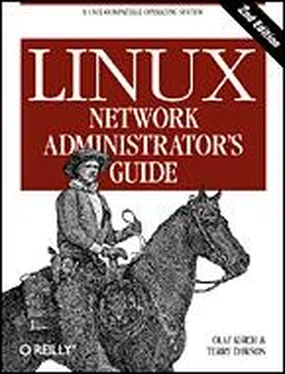= foo.bar
Articles are locally filed into the ``foo.bar'' group.
In our simple server configuration we'll carry a small number of newsgroups, so our /var/lib/news/active file will look like:
control 0000000000 0000000001 y
junk 0000000000 0000000001 y
rec.crafts.brewing 0000000000 0000000001 y
rec.crafts.brewing.ales 0000000000 0000000001 y
rec.crafts.brewing.badtaste 0000000000 0000000001 y
rec.crafts.brewing.brandy 0000000000 0000000001 y
rec.crafts.brewing.champagne 0000000000 0000000001 y
rec.crafts.brewing.private 0000000000 0000000001 y
The himark and lomark numbers in this example are those you would use when creating new newsgroups. The himark and lomark numbers will look quite different for a newsgroup that has been active for some time.
The newsgroups file is even simpler. It provides one-line descriptions of newsgroups. Some newsreaders are able to read and present this information to a user to help them decide whether they want to subscribe.
The format of the newsgroups file is simply:
name description
The name field is the name of a newsgroup, and the ‹ description is a single line description of that newsgroup.
We want to describe the newsgroups that our server supports, so we'll build our newsgroups file as follows:
rec.crafts.brewing.ales Home brewing Ales and Lagers
rec.crafts.brewing.badtaste Home brewing foul tasting brews
rec.crafts.brewing.brandy Home brewing your own Brandy
rec.crafts.brewing.champagne Home brew your own Champagne
rec.crafts.brewing.private The Virtual Brewery home brewers group
INN provides the news administrator the ability to control which newsgroups are forwarded on to other news servers and how they will be forwarded. The most common method uses the NNTP protocol described earlier, but INN also allows newsfeeds via other protocols, such as UUCP.
The newsfeeds file determines where news articles will be sent. It normally resides in the /etc/news/ directory.
The format of the newsfeeds is a little complicated at first. We'll describe the general layout here, and the newsfeeds(5) manual page describes what we leave out. The format is as follows:
# newsfeeds file format
site:pattern:flags:param
site2:pattern2\
:flags2:param2
Each news feed to a site is described by a single line, or may be spread across multiple lines using the \ continuation character. The: characters delimit the fields in each line. The # character at the start of a line marks that line as a comment.
The site field names the site to which this feed description relates. The sitename can be coded any way you like and doesn't have to be the domain name of the site. The site name will be used later and will refer to an entry in a table that supplies the hostname to the innxmit program that transmits the news articles by NNTP to the remote server. You may have multiple entries for each site; each entry will be treated individually.
The pattern field specifies which news groups are to be sent to this site. The default is to send all groups, so if that is what you want, just make this field empty. This field is usually a comma-delimited list of pattern-matching expressions. The * character matches zero or more of any character, the. character has no special significance, the! character (if used at the start of an expression) performs a logical NOT, and the @ character at the start of a newsgroup name means "Do not forward any articles that are posted or crossposted to this group." The list is read and parsed from left to right, so you should ensure that you place the more specific rules first. The pattern:
rec.crafts.brewing*,!rec.crafts.brewing.poison,@rec.crafts.brewing.private
would send all of the rec.crafts.brewing news heirarchy except the rec.crafts.brewing.poison . It would not feed any articles that were either posted or crossposted to the rec.crafts.brewing.private newsgroup; these articles will be trapped and available only to those people who use this server. If you reversed the first two patterns, the first pattern would be overridden by the second and you would end up feeding articles for the rec.crafts.brewing.poison newsgroup. The same is true of the first and last patterns; you must always place the more specific patterns before any less specific patterns for them to take effect.
flags controls and places constraints on the feed of news articles to this site. The flags field is a comma delimited list can contain any of the items from the following list, delimited by commands:
‹ size
Article must be less then size bytes.
A items
Article checks. items can be one or more of d (must have Distribution header) or p (don't check for site in Path header).
B high / low
Internal buffer size before writing to output.
H [ count ]
Article must have less then count hops; the default is 1.
I size
Internal buffer size (for a file feed).
M pattern
Only moderated groups that match the pattern.
N pattern
Only unmoderated groups that match the pattern.
S size
Start spooling if more than size bytes get queued.
T type
Feed types: f (file), m (funnel; the param field names the entry that articles will be funneled to), p (pipe to program), c (send to stdin channel of the param field's subprocess), and x (like c, but handles commands on stdin).
W items
What to write: b (article bytesize), f (full path), g (first newsgroup), m (Message ID), n (relative path), s (site that fed article), t (time received), * (names of funnel feed-ins or all sites that get the article), N (newsgroups header), D (distribution header), H (all headers), O (overview data), and R (replication data).
The param field has special coding that is dependent on the type of feed. In the most common configuration it is where you specify the name of the output file to which you will write the outgoing feed. In other configurations you can leave it out. In yet other configurations it takes on different meanings. If you want to do something unusual, the newsfeeds(5) manual page will explain the use of the param field in some detail.
There is a special site name that should be coded as ME and should be the first entry in the file. This entry is used to control the default settings for your news feeds. If the ME entry has a distribution list associated with it, this list will be prepended to each of the other site entries before they are sent. This allows you to, for example, declare some newsgroups to be automatically fed, or automatically blocked from feeding, without having to repeat the pattern in each site entry.
We mentioned earlier that it was possible to use some special feeds to generate thread data that makes the newsreader's job easier. We'll do this by exploiting the overchan command that is part of the INN distribution. To do this, we've created a special local feed called overview that will pass the news articles to the overchan command for processing into overview data.
Our news server will provide only one external news feed, which goes to the Groucho Marx University, and they receive articles for all newsgroups except the control and junk newsgroups, the rec.crafts.brewing.private newsgroup, which will be kept locally, and the rec.crafts.brewing.poison newsgroup, which we don't want people from our brewery seen posting to.
Читать дальше



![Andrew Radford - Linguistics An Introduction [Second Edition]](/books/397851/andrew-radford-linguistics-an-introduction-second-thumb.webp)








